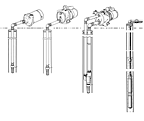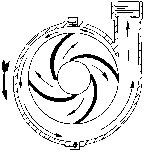
Water, and other fluids for that matter, can be moved in many ways. If water is above where you want it, gravity can get it to its destination. If you need to get it higher than where it is, you'll need a water wheel or some sort of pump. There are ram pumps, piston pumps, gear pumps, diaphragm pumps, lift pumps, centrifugal pumps, etc., each having its own place in the sun (or under the ground as the case might be). Some are positive displacement pumps capable of moving relatively small amounts of fluids at very high pressures, way more than is needed in most water system applications. Others, like the water wheel and centrifugal pump, don't produce much pressure or lift, but can move very large amounts of water. But, if configured properly, as will be pointed out later, centrifugal pumps can produce a respectable amount of pressure.
Four basic types of pumps commonly are used in ground water applications. They are the straight centrifugal, the shallow well jet pump, the deep well jet pump and the submersible pump. All four types will be described in detail as we go along. So that you can have a mental image of each, here are brief descriptions and pictures of typical examples of each. You also should know that all four types are variations of the basic centrifugal pump.
1. The straight end suction centrifugal consists of a motor to provide the energy, an impeller to spin and accelerate the fluid, water in this case, a volute to concentrate the water and build pressure and a housing or case to contain the pressure and provide a place to attach the pipes to the pump. These systems are called "end suction" because the suction pipe is connected to the end of the pump opposite the motor. An end suction centrifugal pump can draw water from as deep as 20 feet.
2. A shallow well jet pump is an end suction centrifugal pump with an attachment on the front of the pump housing which boosts the pressure. The attachment, called a jet assembly, uses a venturi to convert some of the energy from the centrifugal portion of the pump into pressure, both positive pushing pressure and negative vacuum producing pressure. A shallow well jet pump can draw water from as deep as 25 feet.

4. A submersible pump has the same parts as a straight centrifugal pump, but the parts are all small enough in diameter, even the motor, to fit into a well. Although there are single impeller submersible pumps used for special applications, most submersible pumps have more than one impeller/volute assembly. Each impeller/volute assembly is called a stage and each stage adds to the pressure produced by the one before it. For very deep wells, it is not uncommon to have more than 50 stages. A multi-stage submersible pump can pump from more than 1,000 feet deep.
As we said, most water systems pumps, whether they are multi-stage submersible pumps, shallow or deep well jet pumps or end-suction centrifugal pumps, are based on the principle of the centrifugal pump. In a centrifugal pump, an impeller, rotating at high speed, causes water to accelerate as it moves from the inlet, or eye at the center of the impeller, to the outlet at the outside edge of the impeller, creating pressure at the outlet, and a partial vacuum at the inlet. This acceleration is caused by centrifugal force, thus the name centrifugal pump. See Figure 2. The amount of pressure that can be produced by a centrifugal pump increases as the diameter of the impeller increases and as the speed at which the impeller is spinning increases.
The other major component of the wet-end of a centrifugal pump (as distinguished from the motor) is the pump housing, called a volute in an end-suction centrifugal, and called a diffuser in a submersible or jet pump. Its purpose is to contain the water pumped by the impeller and direct it to the pump discharge or to the inlet of the next impeller in a multi-stage pump. The closeness of the fit between the inlet of the impeller and the pump housing affects the pump's performance. If there is too much clearance, some of the water that has been pumped through the impeller simply will leak around the impeller and back to the inlet, reducing the discharge pressure and the amount of water delivered. Not only is this fit an important element in the design and manufacture of a pump, it can deteriorate during normal usage due to corrosion or erosion of the pump impeller and housing, decreasing a pump's performance.
Next month we will continue this discussion on pump basics with a look at how centrifugal pumps make pressure.
Report Abusive Comment